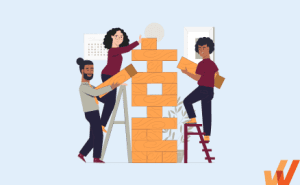What Is Collaborative Learning? (+Theories, Examples, Exercises)
- Published:
- Modified: August 7, 2024


Corporate learning and development have evolved significantly over the past decade. Organizations and educational institutions have moved from traditional, face-to-face learning to more engaging, adaptive learning experiences that enable individuals to test their knowledge with hands-on experiences.
Research shows that learners thrive on real-life exercises and social learning environments, stimulating critical thinking and enhancing cognitive development through practical, contextual experiences.
This is why 60% of L&D professionals believe collaborative learning is essential to make their efforts more relevant and engaging.
Collaborative learning fosters a more emotionally aware and motivated workforce and ensures knowledge retention and practical application through active engagement and diverse perspectives. As a result, companies that implement collaborative learning initiatives see substantial benefits in employee satisfaction and organizational performance.
What Is Collaborative Learning?
Collaborative learning is an educational approach involving joint intellectual effort by team members who engage in activities together, often in small groups. This method is based on the idea that learning is a naturally social act in which participants talk among themselves. It leverages individuals’ diverse skills and perspectives to enhance the learning experience, fostering critical thinking, problem-solving, and learning retention through active engagement and interaction.
Collaborative Learning vs. Cooperative Learning
Here are the most significant differences between collaborative learning and cooperative learning.
Aspect | Collaborative Learning | Cooperative Learning |
Definition | An educational approach where individuals work together to achieve a common goal, emphasizing mutual engagement in a coordinated effort. | A structured form of group work where each member is responsible for a specific part of a task, focusing on individual accountability within the group. |
Focus | Focuses on working together and the learning that occurs through interaction. | Focuses on the end product and ensuring each member fulfills their assigned role. |
Interdependence | High interdependence with all members contributing equally to the group’s success. | Individual accountability is emphasized, with each member responsible for their part of the task. |
Interaction | Encourages open-ended discussion and exchange of ideas among group members. | Often involves more controlled interactions, with specific goals for each group member. |
Assessment | Group performance is assessed collectively, focusing on the collaborative process. | Individual performance is often assessed in addition to the group’s overall success. |
Examples | Group projects, brainstorming sessions, peer teaching. | Jigsaw activities, divided research assignments, structured peer reviews. |
Learning Outcomes | Develop critical thinking, problem-solving, and interpersonal skills. | Ensures mastery of content and develops responsibility and accountability. |
Collaborative Learning Theories
Let’s discuss some of the most common collaborative learning theories.
1. Social learning theory
Developed by Albert Bandura, the Social Learning Theory emphasizes the importance of observing, modeling, and imitating the behaviors, attitudes, and emotional reactions of others. It suggests that learning is a social process heavily influenced by interactions with others and observing behaviors in a social context.
Key concepts of social learning theory:
- Observation: Learning by watching others, especially role models.
- Imitation: Replicating observed behaviors.
- Modeling: Demonstrating behaviors for others to observe and imitate.
- Vicarious Reinforcement: Learning through observing the consequences of others’ actions.
Types of social learning exercises to apply social learning theory:
- Mentorship programs: Pairing less experienced employees with seasoned professionals to facilitate learning through observation and guidance.
- Group activities: Encouraging learning through peer interactions, where members can observe and model effective behaviors.
- Role-playing: Using scenarios to demonstrate and practice new skills in a social context.
2. Constructivist learning theory
Constructivist Learning Theory, influenced by the work of Jean Piaget and Lev Vygotsky, states that learners construct their understanding and knowledge of the world through experiences and reflecting on those experiences. It emphasizes active learning, where learners are actively involved in the process of meaning and knowledge construction as opposed to passively receiving information.
Key concepts of constructivist learning theory:
- Active learning: Engaging with the material through hands-on activities and reflection.
- Schema: Frameworks for understanding and interpreting information.
- Scaffolding: Support provided by instructors that is gradually removed as learners become more competent.
- Social interaction: Learning through social contexts and interactions with others.
Types of constructivist learning exercises to apply constructivist learning theory:
- Project-based learning: Engaging learners in projects that require collaboration and active participation.
- Group discussions: Facilitating discussions allows learners to share their perspectives and construct knowledge collectively.
- Problem-based learning: Encouraging learners to work together to solve real-world problems.
3. Cognitive apprenticeship
Cognitive Apprenticeship is a theory that emphasizes learning through guided experiences and social interaction. It focuses on the process of making thinking visible, where experts articulate their thought processes while performing tasks, and learners gradually take on more responsibility. It’s built on the concept of the 70-20-10 learning rule, which states that learners acquire 70% of knowledge and skills from hands-on experiences, 20% from social interactions, and 10% from traditional training.
Key concepts of cognitive apprenticeship:
- Modeling: Experts demonstrate the process while verbalizing their thought processes.
- Scaffolding: Providing support to learners, which is gradually removed as they gain competence.
- Reflection: Encouraging learners to reflect on their own learning and thought processes.
- Articulation: Having learners verbalize their understanding and reasoning.
Types of cognitive apprenticeship exercises:
- Shadow learning: Allowing learners to observe and learn from experts in real-world settings.
- Guided practice: Providing structured opportunities for learners to practice skills with expert feedback.
- Mentorship and coaching: Pairing learners with experienced mentors who guide them through the learning process.
4. Community of practice (CoP)
Introduced by Jean Lave and Etienne Wenger, a Community of Practice is a group of people who share a common interest or profession and learn from each other through regular interaction. Learning is seen as a social process that occurs within a community of people who share common practices, beliefs, and understandings.
Key concepts of community of practice:
- Domain: The area of shared interest or practice.
- Community: The relationships and interactions among members.
- Practice: The shared repertoire of resources, experiences, stories, tools, and ways of addressing recurring problems.
Ways to apply community of practice principles in the workplace:
- Knowledge sharing platforms: Creating online forums, enabling employees an internal wiki, or building an intranet portal where employees can exchange knowledge and experiences.
- Regular meetings: Regular meetings or workshops for community members, learners, and employees to discuss challenges and share best practices.
- Collaborative projects: Encouraging cross-collaboration between team members to collaborate on projects that benefit from their collective expertise.
Types of Collaborative Training Exercises in the Workplace
Here are a few examples of collaborative training in the workplace.

1. Brainstorming sessions
Brainstorming sessions involve team members gathering to generate ideas and solutions for a specific problem or project. The emphasis is on free thinking and creativity, and all participants are encouraged to contribute their thoughts without immediate criticism or evaluation.
Here’s how to set up brainstorming sessions that foster collaboration learning:
- Set a clear objective for the session.
- Encourage all participants to share ideas openly.
- Use techniques like mind mapping or the round-robin method to ensure everyone contributes.
- After the brainstorming phase, evaluate and prioritize the ideas collectively.
2. Team-based projects
Team-based projects require employees to work together to complete a project or solve a problem, leveraging their collective skills and knowledge. These projects strengthen teamwork and allows employees to leverage each other’s strengths and expertise.
Here’s how to set up team-based projects to drive peer-to-peer collaboration:
- Define clear goals and roles within the team.
- Assign a project that requires collaboration and interdependence.
- Facilitate regular team meetings to discuss progress and address challenges.
3. Collaborative learning community
A collaborative learning community is an environment that fosters collaboration to solve problems and meet new objectives. It prioritizes open communication and gives individuals the opportunity to learn from and teach others.
Here’s how collaborative learning communities work:
- Form groups based on common learning interests or goals.
- Schedule regular meetings and assign rotating facilitators.
- Encourage members to share resources and lead discussions on different topics.
4. Peer learning
Peer-to-peer learning involves employees learning from each other through discussions, mentorship, and shared activities. This is one of the best ways to get employees to share their knowledge and also relieves the L&D teams from constantly creating and updating employee training materials.
Here’s how peer-to-peer learning works:
- Pair employees with peers who have complementary skills or knowledge.
- Facilitate regular peer review sessions and feedback opportunities.
- Encourage collaborative problem-solving and knowledge sharing.
5. Jigsaw method
The jigsaw technique is a collaborative learning method in which groups and projects are divided among smaller groups of employees. Every individual in the group is assigned a particular subtopic to focus on. Once they become experts in a specific portion of the puzzle and understand how it fits into the group’s jigsaw, they coach their partners.
This technique is very helpful in promoting cooperation and group success among employees, as employees rely on one another to complete the jigsaw.
Here’s how the jigsaw learning method works:
- Divide the learning material into sections.
- Assign each section to a different team member to learn and become an “expert” in.
- Each member teaches their section to the rest of the team.
- Combine the segments to complete the overall task.
6. Think-pair-share
Think-pair-share is one of the most common yet low-effort strategies for collaborative training. It allows for quick collaboration and active learning in pairs.
As the name implies, the think-pair-share technique involves three steps: thinking (brainstorming on a topic), pairing (creating employee groups), and sharing (groups discussing their ideas). This technique gives workplace meetings a structured approach and prompts employees to think critically.
Here’s how think-pair-share works:
- Present a question or problem to the group.
- Allow individuals time to think and write down their thoughts.
- Pair up with participants to discuss their ideas.
- Have pairs share their conclusions with the larger group.
7. Group problem-solving
Group problem-solving is a type of collaborative learning where a group of learners is given a specific problem to solve over a set timeframe. This technique helps improve communication and productivity in a team and motivates learners to seek a deeper understanding of concepts.
How it works:
- Present a complex problem that requires a collective effort to solve.
- Facilitate group discussions and brainstorming sessions.
- Encourage diverse perspectives and critical thinking.
- Develop and implement a solution collaboratively.
8. Hackathons
Hackathons are intensive, time-bound events where employees collaborate to develop innovative solutions or products. It encourages creativity and rapid problem-solving while fostering cross-functional collaboration and innovation.
Here’s how hackathons work:
- Define a clear goal or challenge for the hackathon.
- Form diverse teams with a mix of skills and expertise.
- Provide resources and support, such as mentors and tools.
- Set a fixed time frame for the event.
- Present solutions or products at the end of the event.
Best Practices For Fostering a Collaborative Learning Environment
Here are a few best practices for creating a collaborative learning and training environment.
1. Create cross-functional teams
To create cross-functional teams, ensure they include members with various skills and backgrounds to provide different viewpoints and expertise. Also, clear objectives and expectations should be set for the team to focus their efforts and align their activities.
Bringing together members from different departments and areas of expertise to work on projects enhances innovation and problem-solving.
2. Encourage mentorship and peer learning
Mentorship and peer learning involve experienced employees guiding and supporting less experienced colleagues, facilitating knowledge transfer and skill development through direct interaction.
3. Facilitate group discussions
Organize regular meetings with a clear agenda and objectives headed by skilled facilitators to guide discussions, keep them on track, and ensure everyone has a chance to contribute. These group discussion meetings encourage open dialogue among employees, allowing them to share ideas, perspectives, and solutions collaboratively.
4. Utilize collaborative technology and tools
Collaborative technology enables employees to work together efficiently, regardless of location. Choose tools that fit your organization’s needs, such as project management tools (e.g., Trello, Asana), communication platforms (e.g., Slack, Microsoft Teams), and document-sharing services (e.g., Google Drive, SharePoint).
Provide training for your collaborative tools to ensure all employees can use them to their full potential. Implementing a digital adoption platform like Whatfix helps provide training on any software or application via contextual in-app guidance and real-time assistance to help employees learn how to use the tool effectively.
Whatfix integrating seamlessly with any applications, enabling end-users with interactive walkthroughs, contextual pop-ups, and self-help menus that guide employees through an application, its features, and their contextual tasks. Whatfix’s analytics features help organizations track usage and identify areas for further training, ensuring continuous improvement in tool adoption and proficiency.
Software clicks better with Whatfix's digital adoption platform
Enable your employees with in-app guidance, self-help support, process changes alerts, pop-ups for department announcements, and field validations to improve data accuracy.
5. Promote a culture of knowledge-sharing
Implement platforms such as intranets, wikis, or knowledge bases where employees can share and access information. A knowledge-sharing culture encourages employees to share information, insights, and expertise freely within the organization, fostering continuous learning and improvement.
6. Foster open communication and feedback
Establish regular channels for feedback, such as surveys, suggestion boxes, and open forums, to create an environment where employees feel comfortable expressing their ideas, concerns, and feedback without fear of judgment or retribution.
Benefits of Collaborative Learning In the Workplace
Here are some of your organization’s most significant benefits of collaborative learning.
1. Building a learning culture
A collaborative learning fosters a robust learning culture by encouraging continuous development and knowledge sharing among employees. The collaborative approach creates a supportive atmosphere where learning is valued, leading to a more engaged and proactive workforce.
2. Increases employee skills and knowledge
Collaborative learning significantly increases employee skills and knowledge by leveraging the diverse expertise and experiences within the team. Employees are exposed to different perspectives and methods through group projects, peer teaching, and shared problem-solving, enhancing their competencies in various areas.
3. Better knowledge retention
Better knowledge retention is a crucial benefit of collaborative learning, as it involves active engagement and peer teaching, which reinforce understanding and memory of the training material. When employees discuss and explain concepts to each other, they solidify their own understanding and are more likely to remember the information. This active involvement in the learning process makes the material easier to recall.
4. Better teamwork
Collaborative learning improves teamwork by promoting effective communication and strong employee working relationships. When team members work together on projects and solve problems collectively, they learn to appreciate each other’s strengths and develop mutual respect. As a result, teams become more adept at working together, which enhances overall organizational performance.
5. Improves employee engagement and retention
Employees participating in collaborative learning are more engaged and satisfied with their jobs, as they feel valued and supported in their development. The interactive and inclusive nature of collaborative learning makes work more enjoyable and stimulating. Moreover, the opportunities for professional growth and continuous learning provided by collaborative learning initiatives make employees more likely to stay with the company long-term, contributing to a stable and skilled workforce.
Real-World Examples Of Collaborative Learning
Here are some real-life examples of how brands implement collaborative learning to boost their learning initiatives.
1. Google’s G2G Program
Google’s G2G program is an internal initiative where employees volunteer to teach their peers on various topics, fostering a culture of continuous learning and peer-driven knowledge sharing. This program covers various subjects, from technical skills such as coding and data analysis to soft skills such as leadership and mindfulness.
By empowering employees to teach and learn from each other, Google enhances skill development and builds a supportive, collaborative environment. This approach not only helps in personal growth but also drives innovation and keeps the workforce agile and informed about the latest trends and technologies
2. Microsoft's hackathons
Microsoft organizes regular hackathons to encourage innovation and collaborative problem-solving among its employees. These events bring together participants from various departments and backgrounds to develop new solutions and products within a limited timeframe.
By working in diverse teams, employees can leverage different perspectives and expertise, which enhances creativity and rapid prototyping. The hackathons also provide mentorship and networking opportunities, further fostering a collaborative and innovative culture within the company. This approach has led to the development of numerous successful projects and has significantly contributed to Microsoft’s reputation as a leader in technological innovation.
3. IBM's innovation jams
IBM’s Innovation Jams are large-scale online collaborative events that gather employees, clients, and partners from around the globe to brainstorm and develop innovative ideas. These events leverage advanced digital platforms to facilitate real-time collaboration and discussions, combining insights from various industries and disciplines.
The Jams have successfully generated a wealth of innovative solutions by harnessing the collective intelligence of diverse participants. This initiative drives innovation and strengthens relationships with clients and partners, showcasing IBM’s commitment to collaborative learning and open innovation.
Collaborative learning is an effective approach to enhancing employee skills, fostering innovation, and building a strong learning culture within the workplace. Collaborative learning drives individual and organizational performance by promoting teamwork, improving knowledge retention, and increasing engagement.
To maximize the benefits of your collaborative learning efforts, consider integrating advanced technological solutions such as Whatfix DAP . Whatfix provides in-app guidance and in-the-moment support, making the learning process seamless and efficient. With Whatfix, employees receive contextual, real-time assistance directly within the applications they use, enabling them to learn new tools and processes without disrupting their workflow.
Whatfix’s interactive walkthroughs, tooltips, and self-help widgets ensure that employees have immediate access to the information they need, precisely when needed. This enhances the learning experience and significantly reduces the time required to become proficient with new systems and technologies. Moreover, the platform’s analytics capabilities allow organizations to monitor usage, identify areas for improvement, and tailor training programs to meet specific needs.
By implementing Whatfix, organizations can support a continuous learning culture, empower employees with the tools and knowledge they need to succeed, and ultimately drive better business outcomes.
To learn more about Whatfix, schedule a free demo with us today!
Request a demo to see how Whatfix empowers organizations to create scalable employee training flows built directly into your enterprise applications.
Thank you for subscribing!


